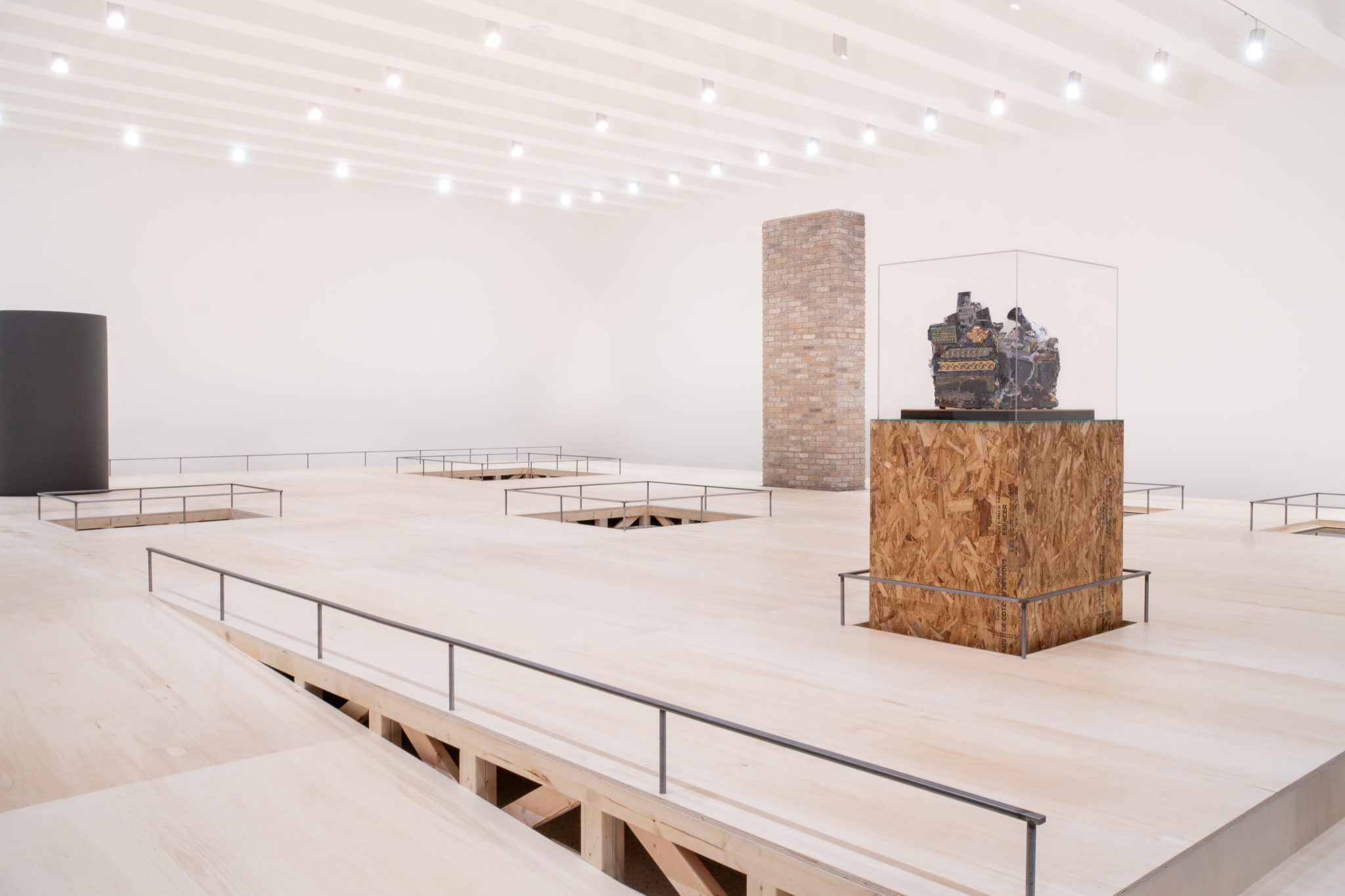“I’m not necessarily interested in people always getting what it’s about”
My first encounter with the work of Kahlil Robert Irving was as part of the Social Works II exhibition at Gagosian, London, in 2021: two pallets sat at the centre of the room, lined with black tiles flecked with hundreds of dots of white. The work, titled Millennia – (through space and street) (2021), poses an easy inversion, in which walking along staring at the ground becomes a gaze into a starlit sky. Alongside these elusive constellations embedded in its cracked surface are occasional scraps and images: a snippet of a headline that reads ‘Whites Only’, an image of the artist’s face as if from a social media site, bits of smashed ceramic vase. It is a vision of outer space littered with terrestrial politics and prejudices. Such seemingly casual displacements and transformations are of a piece in Irving’s assemblages, prints and sculptures, which gather what might appear as random flotsam and jetsam of life, but with an attentiveness to the import and politics that such gathering represents. Working primarily with ceramics, Irving produces facsimile objects and images, mashing them into concise excavations of the recent past. One body of work consists of what look like cross-sections from a trash compactor, neat rectangular bases from which sprout mangled tangles of stuff, in which we might discern the outline of a soda can, a cigarette box, a takeaway burger box, their surfaces crawling with superimposed words and patterns. In a project he executed for MoMA last year, such sculptures sat alongside posters that lined the wall and some of the plinths too, presenting hundreds of overlapping images from news sites, album covers and memes. Both approaches share a sense of grasping all that is ready-to-hand in order to capture an accurate distillation of the present, a voracious portraiture. Shortly after opening his exhibition Archaeology of the Present at the Walker Art Center, in Minneapolis, in February, the St Louis-based artist took time to reflect on ambivalence, the act of collage and loss.
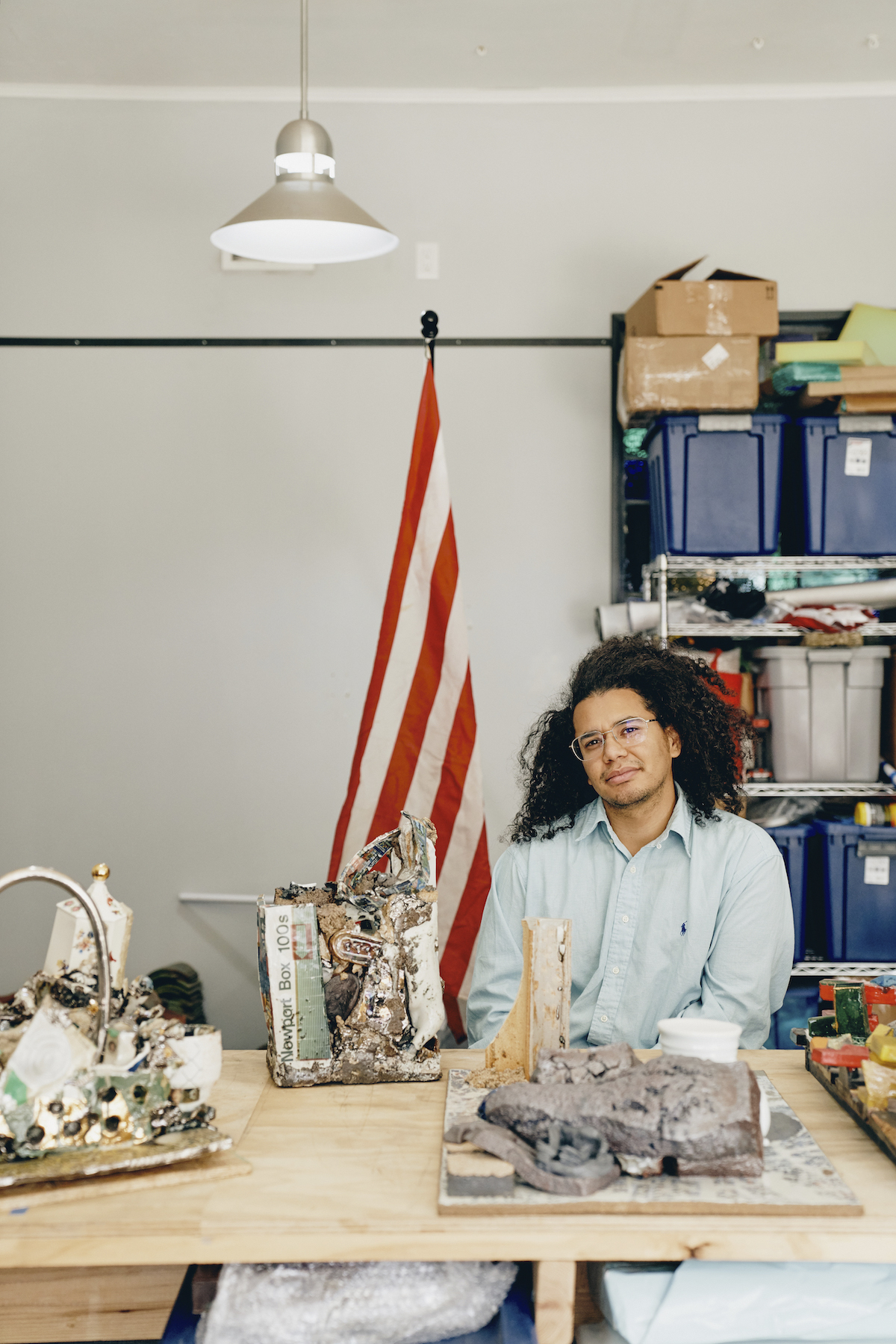
Sampling Slippage
ArtReview Despite the fact that it is mostly sculptural, the word ‘collage’ seems to be appropriate when describing your work. There’s a strong sense of looking and gathering: images, clippings, found objects that sometimes become surfaces or mashed-together three-dimensional works. How do you decide what becomes part of these?
Kahlil Robert Irving The way I started working was to deal with what was right in front of me: the city, the street, things that were around me. I started using items that I had directly around me but then submerging them in clay and burning them away, making these kind of fossils. The material transformation added an extra ten feet of distance from the object, metaphorically, offering a kind of reverence embedded into the work.
In the current Walker Center show is Streetview | Pool & Paper (Underground Starways), a large square work that’s made up of 140-something ceramic tiles that have images of newspaper, and fragments of different media and images of things that I’ve scanned into a computer. There are thin sheets made out of ceramic to look like The New York Times, and different collage information that references documents desiring to be markers in time. On one sheet is a newspaper article talking about how the Ku Klux Klan burned a ‘K’ onto a Black man’s face; on another is a New York Times headline describing the moment when the United States reached half a million people dead from COVID. The desire is for the work to touch on anything I may be thinking about in that moment, collapsing time and threading different things together. It’s almost like making instant poetry.
During the twentieth century, collage was, for many artists, a device for pictorial production and for creating a relationship to the speed of experience of day-to-day life in a very analogue way. For me, collage is also a space in which slippages can exist. Like the way, say, if [the late American artist and songwriter] Romare Bearden’s collage portraits don’t align to form a true-to-life face, then can I collage conceptual interests, physical interests, material interests and just kind of exist in that slippage? Collage also relates to sampling, to music. It’s like deciphering a code: is it a code? Is it more just a series of sounds? Michael Eric Dyson, talking about his book Holler If You Hear Me: Searching for Tupac Shakur, describes the function of language – how Tupac structured communicating information, and the desire to shift and circumnavigate certain constructions. He describes how Tupac creates a new denotation through a different connotation and a lyrical flourish. I’ve been trying to wrestle with this issue of lyrical flourish in images and physical sculpture.
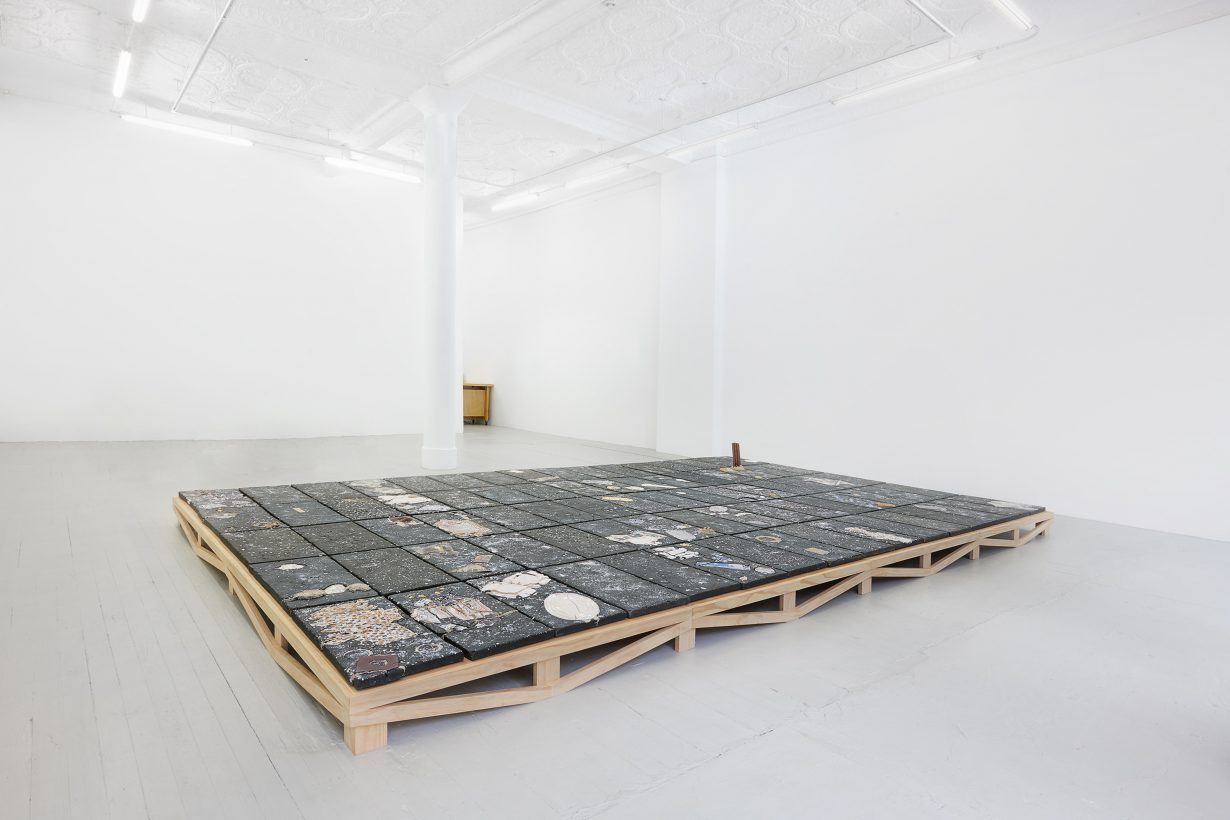
Sculptural Theatrics
AR Within all that, there’s a levelling of certain hierarchies: when you treat, say, a Sprite bottle in the same way as a LinkedIn profile-image and a New York Times article. Do you see that translation to another medium, that kind of flourish, as changing the value of that object?
KRI The value is more just in its presence than in trying to communicate anything specifically about value. I’m not trying to tell you that a soda bottle is valuable. But if I told you that my grandmother, who passed away recently, drank soda, and then the soda bottle was recycled and turned into something else – then it has a sense of an interrelated ecology or system around it that then creates an idea of value. The function of an object is to signify possibility, to signify its existence, not necessarily to put it any one place over another.
Another one of the floor-tile sculptures, [STREET & Stars | (Memories < > Matter) fair and FREEDOM] Black ICE], shown at Callicoon Fine Arts [in New York, in 2019], filled the floor of the room and left only three feet on each side of the gallery. In a lot of ways, it was like turning the gallery into a stage, with the theatrics of pushing people against the wall, making them look down at something that looks like the ground or the street. That pushback of the sculpture, not really being able to see the centre of the piece, was also pushing back against this proprietary relationship that people have with art, where, if you can see it and consume it all, then there’s some kind of sense of walking away with an understanding, with a claim to know what that artwork was about. I’m not necessarily interested in people always getting what it’s about.
Another issue of the collage that doesn’t necessarily always come to light with this work is that no matter what ceramic object I’m making – the overglaze, the enamel, the decal and the lustre – they all relate to the history of decorative ceramics. When I think about decoration and a decorative object, the pattern covers the whole thing, and there’s a certain register in which information is presented. I am not necessarily working with any specific registration, but I am interested in what information is seen, what that offers the viewer. I think of it existing as something and nothing, giving and taking. You can take it as is if you want to, or if you want to inquire more, you can. What is the space between the work and something that is being implicated into the work? Is there another way to present it? If people walk away and understand that it’s made up of facsimile objects, that in itself is good. Or, say, someone saying: that one sculpture where I saw that picture of that woman, it looked like an obituary and it gave me solace in relationship to dealing with loss. That’s also there, because they can connect to my reference to my loss. It can be a more personal or dynamic relationship.
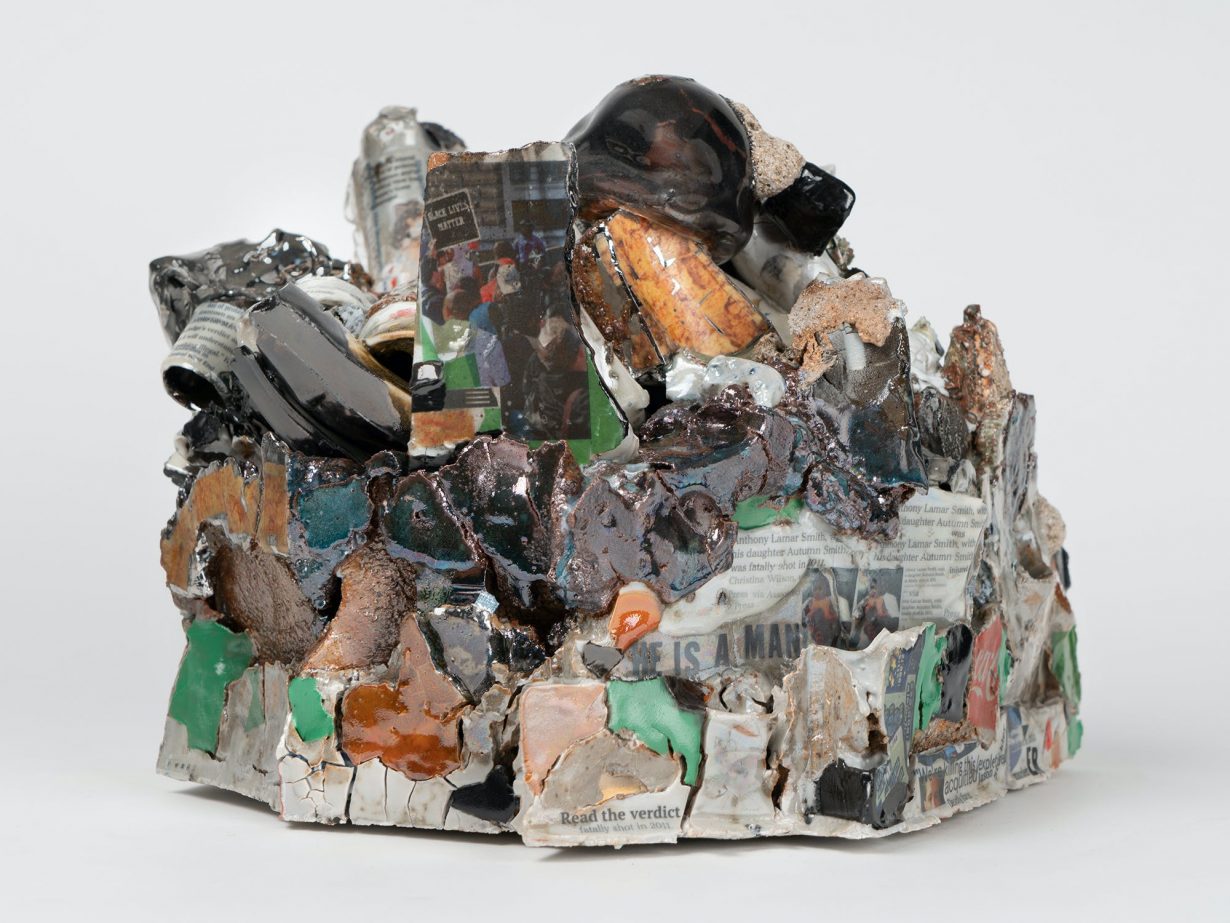
AR So, giving people just enough details, while still leaving some space to project themselves into the work?
KRI Collage was just a starting place for me to relate to the history of ceramic production, but then also a way for personal information to enter the work. My disinterest in claiming it to be communicating that [information] is, in one way, a self-protective measure. Say I am talking about Black space, because a lot of the work is black – but I’m not necessarily specifically identifying Blackness as the topic. And I think often there’s this complication of the Black experience being communicated in a very specific way, where it’s, for example, portraits putting a Black person in the place where a white person had been; or talking about some kind of trauma or violence; or hypersexualisation of the body, or opening up the psyche, and like the problematics of having to cut yourself open and give your all for the audience for there to be some kind of value. For me there’s a schism between just that and trying to make something to which the general audience might have access and a space in which Black people can access certain information to which everybody else won’t necessarily have access.
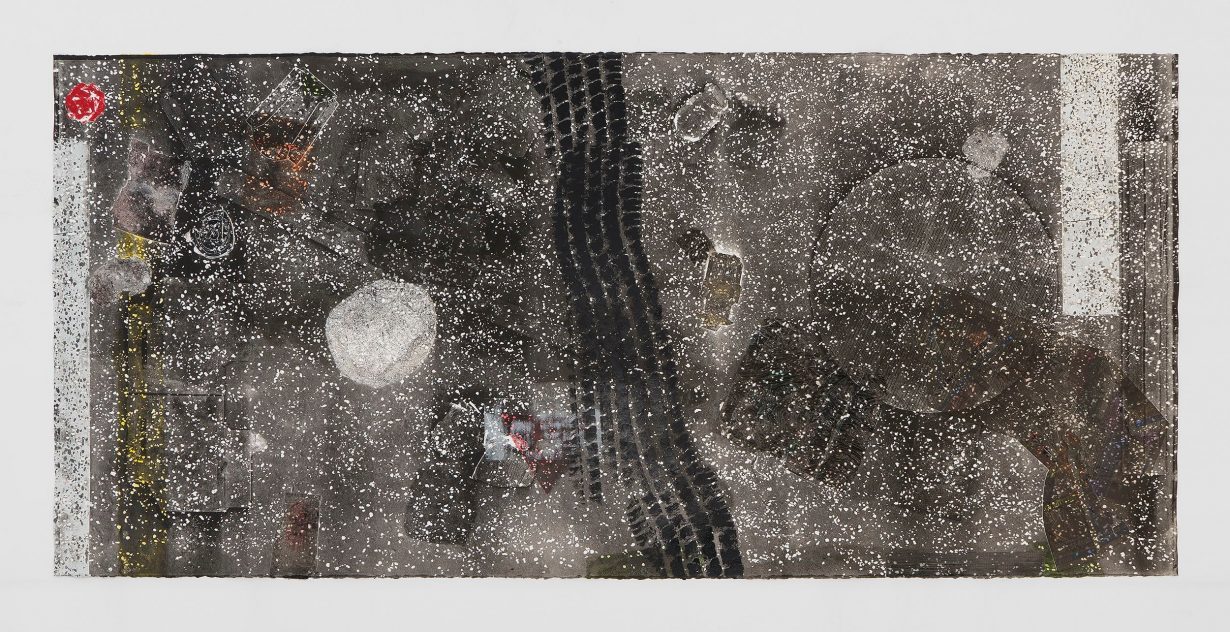
Infinite and Beyond
AR The floor pieces ask us to look down into the depths of space, to suggest the pavement as a glimpse of the infinite. The title of the Walker show poses the exhibition as an archaeological site; do you think of your work as layers of geology and detritus for us to dig through? What do you think we might find?
KRI I feel like a lot of my work is around the idea of a ground: the pictorial space of the screen as the ground, the surface of a canvas that’s gessoed as a ground, and the ground as the surface of something you walk on. The conflation of the connotations of ground is something that I’m really interested in playing with.
I think about my work as a kind of abstraction that is layered and incestuous and feeding into itself, and regurgitating from itself, and buying back into itself, and then presenting and folding back into itself, flourishing or dying, and coming back into a kind of form, and never truly being resolved. I would love to get to a place where there’s a resolution with my floor sculptures; but in facing how physical the ground and the asphalt street are – the layers of violence that have taken buildings and communities down into the ground, and never being able to rise again – there can’t be any resolution. The ground sculptures are a kind of weird demarcation for that liminal space that has not been necessarily registered or remembered, nor can it actually even be pinpointed. One of the floor sculptures is called Ground Gate – [Way View, glam and glitter (Aligned)] Portal, and having recently lost my grandmother, it’s like: where do people go afterwards? You’re making reference to the infinite, and the beyond. Can there be room for things to exist in a way that all this doesn’t necessarily have to tie in explicitly? How far can you stretch a link?
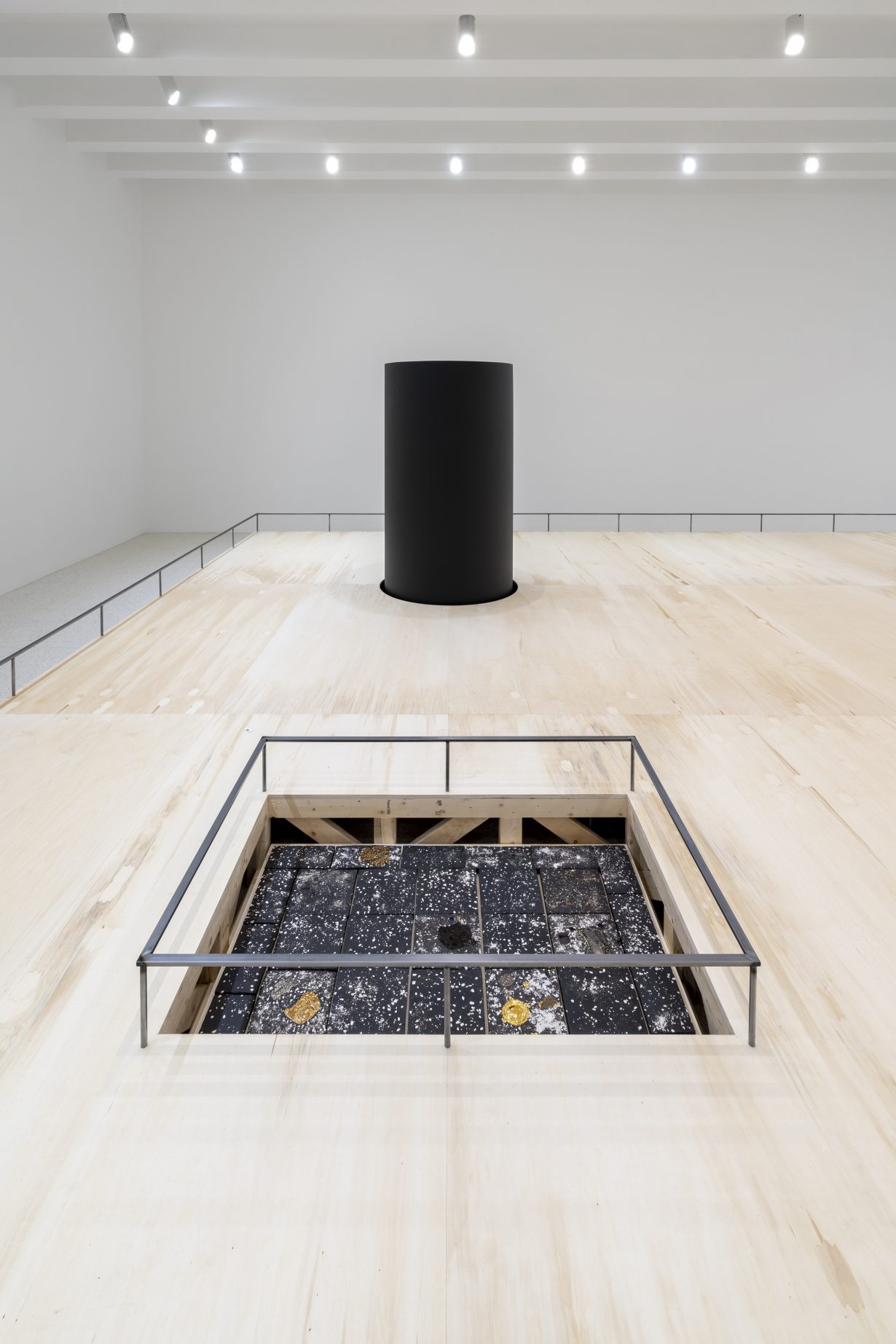
AR Your work has been moving towards bigger pieces. Are you interested in the language of monumentality?
KRI I would like to make sculptures that are bigger, but I understand my material limitations. Ceramic can only get so big: when they get to a certain size they need to be made in parts. That’s one reason why I started to make the floor sculptures in tile: it was a way to deal with the illusionistic issue, but also to deal with spatial navigation and the practicality of just packing things up into boxes. At the moment, with the idea of the monument and dealing with scale, making large things relates to loss. It’s not to fill that loss, but to think about the impact of the memory of the person being memorialised, about experiences with that person, and how those aspects might come into some kind of poetic space with me. I don’t know if I’m necessarily searching for answers, but I know in my work in a lot of ways, in a lot of projects, I’m weeping.
Archaeology of the Present is at the Walker Art Center, Minneapolis, through 21 January 2024. Irving’s work will also be included in Bold Tendencies 2023: Crisis, London, through 16 September
